
The Online Newsletter of the Atlanta Recreation and Fun Club for Dogs, Inc.
Winter 1995-96
Winter 1995-96 |
|

All events are free to members.
Quarterly Meeting January 28 (Sunday) 12pm. Mimosa Downs Agility Field.
Winter Games January 28 (Sunday) 1-3pm. Mimosa Downs Agility Field. Agility practice, games, and competition for RAD, TAD, and EGAD agility titles.
ARF! Dog Hikers March 3 (Sunday). 10am. ARF! associates and friends will meet at Red Top Mountain for a hike to Lake Allatoona. Take I-75 to exit 123 (about 20 minutes north of Marietta) and follow the signs to the Red Top Mountain Visitors Center. Bring 6 ft. lead, paper towels and plastic bags to clean up after your dog, water, and a picnic lunch for after the hike. Parking is $2, but everything else is free.
Easter Egg Hunt April 7 (Sunday) 1-3pm. Mimosa Downs Agility Field. ARF!'s 4th Annual Easter Egg Hunt.
Agility classes will resume in the spring.
Return to Contents
Scenes from the Halloween Party
October 29, 1995
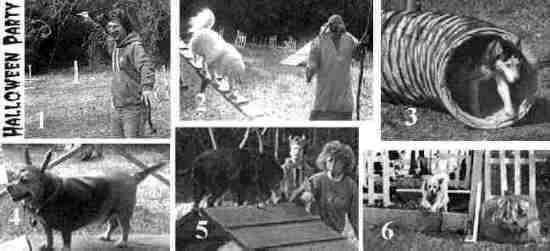
1) Judgment Day: Lucifer, judge of the agility contest, explains rules for passage through "The Agility Course of Horrors."
2) Shepherd directs his "sheep" across "The Elevated Planks of Doom."
3) Siberian Husky Sasha escapes "The Chamber of Fear."
4) Hound of Hell: "Hey Satan, your dog has arrived."
5) Bentley scrambles across "The Ramp of the Damned" while the Prince of Darkness prepares to pass judgment.
6) Casey clears the hideous "Extra Large Smiling Pumpkin Trash Bag Jump," the fifth of
thirteenobstacles on the course.
Return to Contents
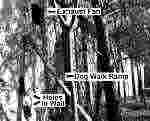
Not-so-agile Thief Learns That Equipment
Should Be Used for Good, Not Evil
Sometime during the week of November 12th, mysterious damage occurred to ARF!'s dog walk. Several of the scaling slats had broken off and were found in the wooded area about 20 feet from the dog walk, near the building that is adjacent to the field. The ramp itself was properly attached to the rest of the dog walk, and, other than the broken slats in the woods, nothing seemed amiss. Observers were baffled as to what had happened, speculating that perhaps some wild animal had ripped the slats off and had carried them into the woods.
Two weeks later the mystery was solved when a burglary occurred at the car detailing business located next to the agility field. This time the ramp of the dog walk was found leaning against the building and a hole was found in the cinder block building, through which the burglar had entered. Nothing was reported stolen by the business's owner, however.
Apparently on November 16th, when damage to the dog walk was first noticed, the bandit climbed the fence at Mimosa Downs and used one of the ramps in an attempt to break into the building. The burglar's plan was to set the ramp against the building and use it as a ladder to climb the wall, remove an exhaust fan, and crawl into the building through the opening.
Evidently, the burglar was unable to loosen the fan and during the attempted crime, several slats on the dog walk became dislodged. He then placed the ramp back on the dog walk so as not to arouse suspicion. He returned a couple of weeks later with the same plan in mind, once again using a dog walk ramp to try to reach the exhaust fan. Unable to remove the fan, he returned to ground level and was able to break a hole through the wall in order to gain entrance to the building.
The "Dog Walk Burglar" is still at large. The wall of the building is in the process of being
restored. New planks for the dog walk have been built and installed.
Return to Contents
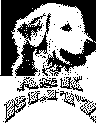
Ask Blitz: Canine Behavior Expert
Blitz has been a recognized expert in canine behavior for over six years. Both parents were also behavior experts and passed this love of canine behavior down to all their children. This month's question is from a young male in Miami.
Dear Blitz:
My owner recently came home to find that someone had destroyed his favorite baseball mitt and he blames me. There are no other dogs living here, but its possible one could have come in while I was in the yard or asleep. I've thought long and hard about this and I can't remember chewing it or anything.
Now my owner says that this shows that I can't be trusted out of my crate alone. I'm eleven months old and almost a grown up. I have two questions. First, can he do this to me? Also, is it true that I can't be trusted just because I forgot to guard the stupid baseball mitt against some strange dog that breaks in while I'm asleep?
(signed) Leather Breath in Florida
Dear Leather:
You must come to grips with the fact that humans are irrational creatures. They can grow fond of the strangest items. My owner got upset just because I redecorated the sofa a little. How was I to know he wanted all of that fabric on the sofa? The other thing you must learn is to demonstrate remorse when one of your owners silly items get destroyed. The best way to do this is to be real quiet for a half hour or so after the discovery. Think about how you'd like your owner to act if he destroyed one of your things like a filling in a real good hole that took you all day to dig, or if he picks up the dead bird you were playing with.
The answer to your first question is, yes your owner can do that. I know it's not right but, until we evolve thumbs and can order firearms through the mail it's a burden we have to live with. Think of it as the price we pay for not having to go to work like a silly human.
The second question is a little tougher. It's possible that you did chew on the mitt a little. Many dogs are so intoxicated by leather that they black out during the experience and never remember the incident. I've heard of a Labrador that got locked in a shoe store overnight and chewed so much leather that he ended up a leather-holic. (You can order my new booklet "Are You A Leather-holic?" $14.95. Take that green paper out of your owner's wallet at night while he's asleep.) Ask yourself these questions:
Do I ever chew leather alone?
Have I ever said "Just one slingback pump and I'll quit"?
Does your tongue say "Florsheim"?
If the answer to any of these questions is yes, you may be a leather-holic. Don't be alarmed, it's a disease, it doesn't mean you're a "BAD DOG". Your owner can send you to my leather abuse clinic for only $55 a day. After two or three weeks you'll be cured of leather chewing. If you ever chew leather again it's your owner's fault. See how that works. So, go to the crate and relax. Remember your owner has to go to a job.
Blitz.
Copyright 1996, Dan Wasson, All Rights Reserved.
Address questions or comments to at Blitzkuvas@aol.com
Return to Contents

Amusing Riddles and Anecdotes
1) What has four legs and one arm?
2) Why do fire trucks carry dogs?
If you pick up a starving dog and make him prosperous, he will not bite you. That is the principal difference between a dog and a man. Mark Twain
A man was selling his dog and his neighbor came over to make an offer. "I was a stand-in for Lassie for many years in the movies," said the dog. "Wow!" said the neighbor. "And I was once the most famous dog in vaudeville," said the dog. "Amazing!" said the neighbor. "And I flew an air force bomber in WWII," said the dog. "I can't believe it!" said the neighbor.
Then he turned to the owner and said, "Why are you getting rid of a talking dog?" "Well," replied the owner, "I'm tired of his lies."
The New York Times recently listed some of the unusual questions that have been asked of the experts at the Butterball Turkey-Talk Hotline, including "How much turkey should I buy for five Great Danes?" and "How do I get my Chihuahua out of the turkey cavity?" The experts were unable to answer the first question with any certainty, but did help extricate the Chihuahua by instructing the caller on how to widen the cavity opening. It wasn't clear if the dog was eager to be set free, though.
Holiday story sent to us from a friend: One year, years ago, my sister and I made cookie ornaments. They were lovely. Slowly they started disappearing from the tree. My mother said it was Greta, the fawn Great Dane. Well, we caught my MOTHER sneaking them off the tree. Poor Greta, she just sniffed them, it was my mother who was eating them.
Encouraging news from the Ansley Parkside Rover Reporter: "The good news is that more and more people are ... stopping to help animals in distress. Only today six cars pulled to the side of Georgia 400 to help get two dogs off the median. Graham crackers and car phones in hand, about a dozen people guided the dogs to safety and notified the owner of their predicament."
Some observations from the Atlanta Journal-Constitution's column, The Vent:
It's scary when a taco costs less than dog food.
Lord help me be the person my dog thinks I am.
If dogs attack your Christmas tree, here is a holiday tree saving tip from a friend: "I x-pen my tree every day as we head out for work, and set it free when we get home again".
I agree with Agassiz that dogs possess something very like a conscience. Charles Darwin
Answers to riddles: 1) A happy pit bull. 2) To help the firemen find the hydrant.
Return to Contents

by Landen Gailey, Our Place or Yours Pet Services
Across the country there is a new sound coming from dog obedience classes. In addition to the "Sit!", "Good girl!" and occasional woofs, it's the crisp clack of a training clicker. Magazine articles have touted "clicker training" as an exciting new method of training. What's it all about anyway?
Dog training methods commonly used during the past fifty years have been largely based on the compulsive training techniques that were used to train dogs for military purposes during the World Wars. Many military dog trainers and training instructors found work instructing dog obedience classes during the fifties, and by the sixties compulsive training practices were dogma and unquestionable. Don't train with food, students were told, and everyone bought chain "choke" collars. "SIT!" students were told to command, then jerk up on the leash and push the dog's rump down.
Compulsive training is still employed in most beginning obedience classes. It's easy for instructors to teach and students to use, and it's "tried and true". It is based on the dog's desire to avoid pain Compulsion works relatively well on a good natured dogs that are not too physically sensitive. But often the result is a slow uninspired worker--a dog who performed the requested exercise, but without any zest or animation. Often the dogs had an unhappy hangdog look. In an effort to remedy this, students are told to be ever more enthusiastic and ebullient in their praise. Still, many breeds of dogs have gained reputations as being unintelligent or untrainable since force methods caused them to just give up and quit.
The quest for a happier working dog led trainers to look around at what the trainers of other types of animals were doing. The TV show Flipper exposed a whole generation of young animal enthusiasts to the intelligence and trainability of marine mammals. How were they trained? You can't put a choke collar on a dolphin or a killer whale! Obviously there were some different solutions that dog training had overlooked. Inducive or Positive Reinforcement training approaches training from another angle. In contrast to compulsive training with its reliance on pain avoidance, positive reinforcement training is based on the desire of the animal to get something that it wants, such as a food treat. It further assumes that the animal is physically able to perform the desired activity, but merely needs to know exactly WHAT will earn him the reward he wants.
Enter the Clicker! This nifty devise with its crisp snapping sound allows the trainer to signal at the exact instant the animal performs the desired action. The dog is conditioned to associate the sound of the Clicker with a food, hence the "Clicker-Treat!" rule. Every time the dog hears the click, he gets a treat. Once the dog understands this, it's literally a snap to get him doing things to earn his Click--and treat. Only when the dog is offering the desired activity over and over for his reinforcement will the cue word be attached.
In reality, since we have to live with our dogs 24 hours a day, some compulsion will inevitably slip in. But clicker training is certainly an important addition to the trainer's toolbox. It is a user friendly (and dog friendly) way to train. It's easy to get started, fun and very forgiving. Punishment, standard fare for compulsive trainers, is not needed. No problem when a response is not right! The absence of a reward is incentive for the dog to work the problem out. With their interest at stake, dogs work harder to earn their clicker-treat!
Copyright 1996, Landen Gailey, All Rights Reserved.
Address questions or comments to at OPOY@aol.com
Editor's note: The illustration accompanying this article depicts Ivan Petrovich Pavlov, the
scientist who accidentally discovered the conditioned reflex, the basis of clicker training.
Pavlov's main area of reseach was digestion. To collect saliva samples from labratory dogs, his
assistants used meat powder to stimulate secretion of saliva. Pavlov soon observed that the dogs
would salivate at the sight of the assistants. Pavlov then began pairing the meat powder with
other stimuli, such as a bell, and made his famous discovery of the conditioned response.
Return to Contents

The "Name the New Agility Field" contest winner was announced at the October 29th Halloween Party. Kathy Morris' entry "Mimosa Downs" was selected by the judging panel. The name recognizes the many mimosa trees that surround the field and provide shade and comfort to both dogs and handlers. Other suggested names (in no particular order) were:
Wiggly Field, Doggy Dew Run, Toco Loco, Fun Is Afoot, Four Footed Fun Field, International House of Agility, Whirled Series Park, Field of Dreams, W.D. Field, Agility Field, Ups 'n' Downs, Skill Hill, Romp 'n' Roll, Canis Fieldarius, Leaps and Bounds, ARF! Four Agile Paws.
Kathy wins a free four-week agility class. Thanks to all who entered.
Return to Contents
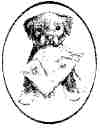
Editor Was Inspired by ARF! NewsletterFrom Greg Elftmann, US Embassy Vladivostok, Russia -- The Rottweiler club people here really like your article on Rottweiler agility training [Fall 1995 ARF! Newsletter], and have asked me to get your permission to translate it and publish it in their new newsletter. They've given me a copy of the first issue to send to you--they're very proud of it, and say that they were inspired by ARF!
A Poem by Uncle Goblin from the Canine Post:
For the Homeless
The city sleeps, only the wind roars
Within the labyrinth of the unfinished building project,
Along the old frozen garbage heap
A single passer-by rushes past.
Dogs are sleeping on the steam pipes of the heating plant,
They need no rug, they need no pillow,
In their dreams are only bagels and jam,
And a fire that burns in the fireplace.
-- Uncle Goblin
Editor's Note: Uncle Goblin is the Canine Post editor's Rottweiler. Uncle Goblin's poem
appeared on page 23 of the Canine Post. The poem was translated by Greg Elftmann.
Return to Contents
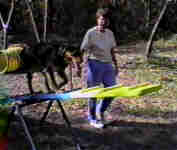
by Steve Elftmann
In one of our beginning agility classes this fall, we had two dogs that looked nearly identical, Bernie and Cassidy. I saw the owners talking with each other fairly regularly, and I thought that they knew each other. Perhaps these two dogs were from the same litter. But Bernie's class registration listed him as a one-year-old mixed breed and Cassidy was listed as a 10-month-old English Shepherd.
I had never heard of an English Shepherd, so I decided to look in some reference books. First I went to the American Kennel Club's "The Complete Dog Book." The index includes English Cocker Spaniel, English Foxhound, English Setter, English Springer Spaniel, English Toy Spaniel, and of course, the Old English Sheepdog - no English Shepherds.
There are plenty of purebred dog breeds that are not recognized by the AKC, so next I pulled out "Simon and Schuster's Guide to Dogs." This book rarely fails to have information on a purebred dogs that are not in the AKC book. Breeds like the Rough-coated Bohemian Pointer, the Xoloitzcuintle, the Billy, the Transylvanian Hound, and even a Swedish Shepherd are described. But not an English Shepherd.
At this point I started to think that Cassidy's owner was just putting me on. I had a friend who claimed his mixed-breed was a very rare purebred - a Peruvian Herder. He didn't fool many people. But English Shepherd is an ingeniously subtle, believable name for a breed of dog.
Later that week I was looking for some information about coondogs to supplement the 1995 Coondog Trials article in this newsletter. As I was going through some United Kennel Club magazines, a familiar dog suddenly appeared. It looked just like Bernie and Cassidy. It was doing agility. It was an English Shepherd. There was also an address for the English Shepherd Association.
It turns out that Bernie and Cassidy had never met before, and that the reason I had been seeing the owners together at class was because they were comparing their very similar dogs. Bernie's owner now thinks he's probably a purebred English Shepherd, now that she's met Cassidy and has seen the UKC magazine article.
Cassidy's owners, the Landers, did a lot of research before selecting an English Shepherd as the right breed of dog for their family. Cynda Byers, Bernie's owner, did a different kind of research before finding her "mixed breed." She had given a friend at the Fayette County Humane Society a list of qualities to look for in a shelter dog and to let her know when the right dog showed up. Soon she got the call, but not for Bernie. When Cynda showed up to look at the other dog, she found and adopted Bernie, whose previous owner had listed as a mixed breed.
As rare as the English Shepherd is, what are the odds that Bernie would have an English
Shepherd agility classmate?
Return to Contents
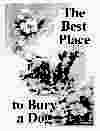
We are thinking now of a setter, whose coat was flame in the sunshine and who, so far as we are aware, never entertained a mean or an unworthy thought. This setter is buried beneath a cherry tree, under four feet of garden loam, and at its proper season the cherry strews petals on the green lawn of his grave. Beneath a cherry tree or an apple or any flowering shrub of the garden is an excellent place to bury a good dog. Beneath such trees, such shrubs, he slept in the drowsy summer or gnawed at a flavorous bone or lifted head to challenge some strange intruder.
These are good places, in life or in death. Yet it is a small matter. For if the dog be well-remembered, if sometimes he leaps through your dreams actual as in life, eyes kindling, laughing, begging, it matters not at all where the dog sleeps. On a hill where the wind is unrebuked and the trees are roaring, or beside a stream he knew in puppyhood, or somewhere in the flatness of a pastureland, where most exhilarating cattle graze. It is all one to the dog and all one to you, and nothing is gained and nothing is lost --if memory lives.
But there is one best place to bury a dog. If you bury him in this spot, he will come to you when you call--come to you over the grim, dim frontiers of death, and down the well-remembered path, and to your side again. And though you call a dozen living dogs to heel they shall not growl at him, nor resent his coming, for he belongs there. People may scoff at you, who see no lightest blade of grass bent by his footfall, who hear no whimper, people who may never really have had a dog. Smile at them, for you shall know something that is hidden from them, and which is well worth the knowing. The one best place to bury a good dog is in the heart of his master.
From the Portland Oregonian, Sept. 11, 1925. By Ben Hur Lampman
Return to Contents
Where noted by copyright , articles in the ARF! Newsletter Online appear with the express consent of the author, who holds all copyrights. Any reproduction of this material, in whole or in part, is prohibited without the express consent of the author.